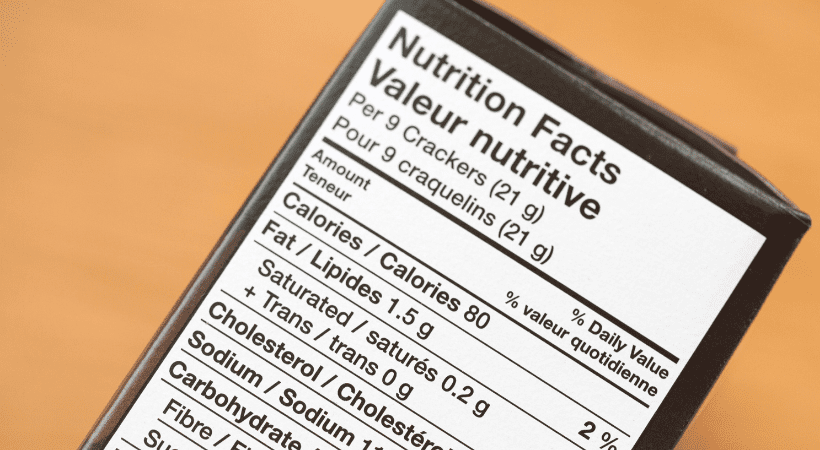Allergen Labelling: A Guide For Food Businesses
Allergen Labelling: A Guide For Food Businesses
Food allergen labelling is an important aspect of UK food labelling regulations. Carrying significant implications for both consumer safety and business integrity, allergen labelling regulations require thorough understanding and strict compliance.
This guide aims to help businesses understand the key requirements of food allergen labelling and provides advice on how to comply with these rules.
If you’re a business looking for further support with allergen labelling, find out about outsourcing your food labelling compliance to Ashbury.
Table of Contents
- What is Food Allergen Labelling and Why is it Important?
- Which Allergens are Required to be Displayed?
- How Should Allergens be Displayed on Food Labels?
- What is Precautionary Allergen Labelling and When Should it be Used?
- Are There Any Exemptions for Food Allergen Labelling?
- Hidden Allergens in Food Products
- Using ‘Free-From’ Claims in the UK
- Maintaining Your Allergen Information
- Further Support With Allergen Labelling
What is Food Allergen Labelling and Why is it Important?
Food allergen labelling refers to the mandatory inclusion of information about allergenic ingredients in the labelling of pre-packed and pre-packed for direct sale foods. This information is crucial for individuals with food allergies, as the consumption of even a small amount of an allergenic ingredient can cause severe, and sometimes life-threatening, allergic reactions.
In the United Kingdom, it is a legal requirement for food businesses to provide accurate information about the presence of allergenic ingredients in their products. This is defined by harmonised EU legislation the Food Information to Consumers Regulation (EU) No. 1169/2011, also known as ‘FIC’ which has been retained in UK legislation.
Whether the presence of an allergen is deliberate (concerning an ingredient) or resulting from processing the food, it must be labelled. This is to protect individuals with food allergies and, by extension, food businesses themselves. Failure to comply with these regulations can result in legal repercussions and damage to a business’s reputation.
Learn More: Food Labelling Regulations UK: A Complete Guide
Which Allergens are Required to be Displayed?
There are hundreds of foods that have been found to cause allergic reactions in individuals globally. Of these, the UK government has identified 14 major allergens that must be declared on food labels, which are:
- Celery
- Cereals containing gluten (such as wheat, rye, barley and oats)
- Crustaceans (like prawns, crabs, and lobsters)
- Eggs
- Fish
- Lupin
- Milk
- Molluscs (such as mussels and oysters)
- Mustard
- Peanuts
- Sesame seeds
- Soybeans
- Sulphur dioxide and sulphites (at levels above 10mg/kg or 10mg/L)
- Tree nuts (such as almonds, hazelnuts and walnuts).
If any of these allergens are present in a food product, they must be clearly labelled on the packaging.
The choice of these particular allergens is based on their potential to trigger severe allergic reactions. This list might evolve in response to advancements in scientific research, consumer dietary patterns and the changing regulatory landscape post-Brexit.
When launching products in countries outside the UK, it is important to get to know the local allergen regulatory requirements, as the allergens list and the format for labelling do change depending on the market.
Learn More: What Information Has to be on a Food Label by Law?
How Should Allergens be Displayed on Food Labels?
Allergens must be clearly displayed on food labels. The name of the allergen should be highlighted in either bold text or a different font size to make it easily noticeable.
The allergenic ingredient should be listed in the ingredients list, with the allergen’s name highlighted. For example, “milk” should be displayed instead of a general term like “dairy”. Derivatives, such as lactose or whey must be declared with a clear reference to the allergen, for instance, “whey (milk)”.
What is Precautionary Allergen Labelling and When Should it be Used?
Precautionary allergen labelling is used when there’s a risk of cross-contamination with an allergenic ingredient during manufacturing, even if the allergen is not an intentional ingredient in the final product. While not a legal requirement, it is recommended by the UK Food Standards Agency only if justifiable where production risks have been properly assessed.
Warnings such as ‘may contain nuts’, ‘made in a factory that also handles milk’, or ‘not suitable for people with allergies to peanuts’ are examples of precautionary allergen labelling. These warnings are designed to inform consumers of the potential risk of allergen contamination, even if the product does not contain the allergen as an ingredient.
However, using such labelling without a genuine risk is misleading and negatively impacts consumer trust. It should not substitute Good Manufacturing Processes (GMP).
Learn More: Precautionary Allergen Labelling: How & When To Use it
Are There Any Exemptions for Food Allergen Labelling?
Foods that are non-prepacked (loose), such as those sold at a market or in a restaurant do not require labelling. However, allergen information must still be communicated through other means, like verbal communication from a member of staff or detailed on a menu.
Additionally, tree nuts do not include ingredients like pine nuts, coconut or chestnuts. Highly processed ingredients, such as wheat-based glucose syrup, dextrose, maltodextrins, fully refined soybean oil and fat, are also exempt. Some small businesses might be exempt from allergen labelling requirements if they can demonstrate that it would be impractical or disproportionate to comply with the regulations.
Hidden Allergens in Food Products
Navigating the world of allergens isn’t always straightforward. Ingredients, additives or processing aids derived from an allergenic ingredient still need to reference the allergen. For example, labels should include indications like “flavourings (contain celery)” to guide consumers who may be allergic to celery.
When it comes to spice mixtures, allergens must be clearly stated even if they account for less than 2% of the product. So, a label should read “ground spices (contains mustard)” if the mixture contains mustard.
Similarly, sulphites declaration is required when they’re present at more than 10ppm in the final product. How you declare them depends on their role in the food product. For instance, if sulphites are present and performing an additive function in the final product e.g. acting as a preservative in apricots, you’d label them as “apricots (apricots, preservatives (sulphur dioxide)”.
If they’re not performing an additive function in the final product e.g. present via carryover and no longer performing a function, the label might read “apricots (sulphites)”. To learn more about this, refer to our guide: Food Additives Legislation & Labelling Advice
Alcoholic beverages with more than 1.2% by volume of alcohol don’t need an ingredient list, but they still need to state any allergenic ingredient clearly. For example, you might see “Contains sulphites” or “Contains barley” on the label.
Using ‘Free-From’ Claims in the UK
Free-from claims help consumers identify products that do not contain the allergenic ingredient that could trigger a reaction. In the UK, there is no specific legislation governing how to apply free-from to your products (except for gluten). The over-arching rule of using a claim is that it must not mislead consumers and you should be able to substantiate its use with evidence.
Before you decide to use a ‘free-from’ claim, it is the responsibility of your business to ensure that comprehensive risk assessment, allergen management, testing plans and traceable product information exist to demonstrate that the allergenic substance cannot be detected in the food.
Maintaining Your Allergen Information
Allergen labelling is only as effective as the quality of the information you have on record. It’s critical to consider how any change to your product, suppliers, processing or transportation could impact the presence of allergens. For example, if your primary supplier is out of stock of an ingredient, you must check for allergens in any replacement stock, and update your specifications and labelling accordingly. Ideally, you should prioritise alternative ingredients with like-for-like allergens present.
If an allergen is intentionally introduced to your products, we recommend communicating the recipe change to consumers beyond updating the ingredients list (which is a legal requirement); for example, adding a statement to your labels such as ‘New Recipe’. Whilst this is not a legal requirement, it is one way to encourage regular customers to look at changes and ensure the product is still acceptable for their dietary needs. Further actions include a statement on your website/marketing materials.
Additionally, we recommend implementing a rhythm and routine of auditing and updating specifications to ensure any supply chain related changes have been captured and that specs remain compliant with regulatory changes.
Further Support With Allergen Labelling
Food allergen labelling is critical in food manufacturing. It protects individuals with allergies and safeguards businesses against legal repercussions and reputational damage. Manufacturers must be vigilant about accurately displaying all major allergens and potential cross-contaminants on their food labels. While there are some exemptions, these should not be exploited as loopholes but understood in their correct context.
As specialists in food labelling compliance, our regulatory experts review your specifications and artworks, providing legal advice and best practice guidance on complying with food allergen labelling requirements. Our team acts as an extension of your internal team to ensure your product information is up-to-date and completely compliant. We enable you to focus on all the other aspects of launching successful products. Contact us for tailored advice.
Next reads
The Peanut Diaries: School and Social Occasions
The Peanut Diaries: Navigating Social Events and Celebrations with Food Allergies
The Peanut Diaries: A Parent’s Journey to Uncovering their Child’s Allergy
Redefining Healthy: What the FDA’s New Rules Mean for Food Labels and Nutrition Claims
Keep up to date with our latest insights
Subscribe to our mailing list to stay in touch with the latest news, insights and updates from Ashbury





